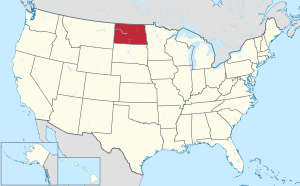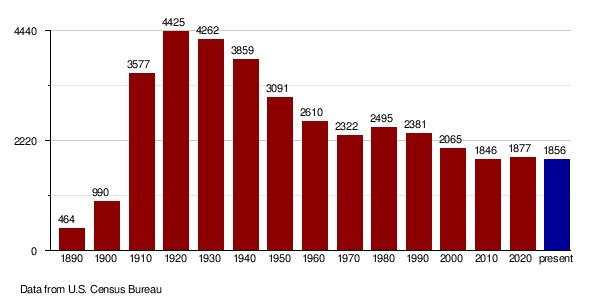County in North Dakota
| Oliver County | |
|---|---|
| County | |
 Missouri River at Cross Ranch State Park. Missouri River at Cross Ranch State Park. | |
 Location within the U.S. state of North Dakota Location within the U.S. state of North Dakota | |
 North Dakota's location within the U.S. North Dakota's location within the U.S. | |
| Coordinates: 47°07′N 101°21′W / 47.11°N 101.35°W / 47.11; -101.35 | |
| Country | |
| State | |
| Founded | April 14, 1885 (created) May 18, 1885 (organized) |
| Named for | Harry S. Oliver |
| Seat | Center |
| Largest city | Center |
| Area | |
| • Total | 731 sq mi (1,890 km) |
| • Land | 723 sq mi (1,870 km) |
| • Water | 8.7 sq mi (23 km) 1.2% |
| Population | |
| • Total | 1,877 |
| • Estimate | 1,856 |
| • Density | 2.6/sq mi (0.99/km) |
| Time zone | UTC−6 (Central) |
| • Summer (DST) | UTC−5 (CDT) |
| Congressional district | At-large |
| Website | olivercountynd |
Oliver County is a county located in the U.S. state of North Dakota. As of the 2020 census, the population was 1,877. Its county seat and only city is Center.
History
The Dakota Territory legislature created the county on April 14, 1885, with territory partitioned from Mercer County. It was named for Harry S. Oliver of Lisbon, North Dakota, a Republican politician and member of the Dakota Territory House of Representatives at the time. The county government was organized on May 18, with Sanger (then known as "Bentley") as county seat. The seat was moved to Center in 1902.
Oliver County is included in the Bismarck, North Dakota Metropolitan Statistical Area.
Geography
The northeastern/eastern boundary of Oliver County is delineated by the Missouri River as it flows southeastward after leaving Lake Sakakawea. The county terrain consists of rolling hills, mostly devoted to agriculture. The terrain slopes to the east, with the highest point a hill near its southwestern corner, at 2,382 ft (726 m) ASL. The county has a total area of 731 square miles (1,890 km), of which 723 square miles (1,870 km) is land and 8.7 square miles (23 km) (1.2%) is water. It is the fifth-smallest county in North Dakota by area.
By sheer coincidence, the county seat, Center, named for being near the geographical center of the county, has also been calculated to be the geographic center of North America.
Major highways
 North Dakota Highway 25
North Dakota Highway 25 North Dakota Highway 31
North Dakota Highway 31 North Dakota Highway 48
North Dakota Highway 48 North Dakota Highway 200A
North Dakota Highway 200A North Dakota Highway 1806
North Dakota Highway 1806
Adjacent counties
- McLean County - northeast
- Burleigh County - east
- Morton County - south
- Mercer County - northwest
Protected areas
- Cross Ranch State Park
Lakes
- Mandan Lake
- Nelson Lake
Demographics
| Census | Pop. | Note | %± |
|---|---|---|---|
| 1890 | 464 | — | |
| 1900 | 990 | 113.4% | |
| 1910 | 3,577 | 261.3% | |
| 1920 | 4,425 | 23.7% | |
| 1930 | 4,262 | −3.7% | |
| 1940 | 3,859 | −9.5% | |
| 1950 | 3,091 | −19.9% | |
| 1960 | 2,610 | −15.6% | |
| 1970 | 2,322 | −11.0% | |
| 1980 | 2,495 | 7.5% | |
| 1990 | 2,381 | −4.6% | |
| 2000 | 2,065 | −13.3% | |
| 2010 | 1,846 | −10.6% | |
| 2020 | 1,877 | 1.7% | |
| 2022 (est.) | 1,856 | −1.1% | |
| U.S. Decennial Census 1790-1960 1900-1990 1990-2000 2010-2020 | |||
2020 census
As of the census of 2020, there were 1,877 people.
2010 census
As of the census of 2010, there were 1,846 people, 756 households, and 554 families in the county. The population density was 2.55 people per square mile (0.98 people/km). There were 905 housing units at an average density of 1.25 units per square mile (0.48/km). The racial makeup of the county was 97.3% white, 1.5% American Indian, 0.2% black or African American, 0.2% Asian, 0.2% from other races, and 0.7% from two or more races. Those of Hispanic or Latino origin made up 1.0% of the population. In terms of ancestry, 66.8% were German, 19.3% were Norwegian, 7.6% were Russian, 6.3% were English, and 4.4% were American.
Of the 756 households, 25.0% had children under the age of 18 living with them, 65.5% were married couples living together, 4.8% had a female householder with no husband present, 26.7% were non-families, and 22.6% of all households were made up of individuals. The average household size was 2.44 and the average family size was 2.84. The median age was 47.6 years.
The median income for a household in the county was $62,308 and the median income for a family was $75,069. Males had a median income of $60,592 versus $28,409 for females. The per capita income for the county was $29,348. About 6.5% of families and 9.7% of the population were below the poverty line, including 13.0% of those under age 18 and 19.6% of those age 65 or over.
Population by decade

Communities
City
- Center (county seat)
Unincorporated communities
- Fort Clark
- Hannover
- Hensler
- Price
- Sanger (originally "Bentley")
Politics
Oliver County voters are traditionally Republican. In only one national election since 1936 has the county selected the Democratic Party candidate (as of 2024).
| Year | Republican | Democratic | Third party(ies) | |||
|---|---|---|---|---|---|---|
| No. | % | No. | % | No. | % | |
| 2024 | 909 | 83.62% | 156 | 14.35% | 22 | 2.02% |
| 2020 | 918 | 86.12% | 129 | 12.10% | 19 | 1.78% |
| 2016 | 830 | 81.61% | 119 | 11.70% | 68 | 6.69% |
| 2012 | 693 | 68.41% | 281 | 27.74% | 39 | 3.85% |
| 2008 | 682 | 65.58% | 332 | 31.92% | 26 | 2.50% |
| 2004 | 790 | 70.60% | 310 | 27.70% | 19 | 1.70% |
| 2000 | 709 | 67.46% | 244 | 23.22% | 98 | 9.32% |
| 1996 | 499 | 48.83% | 333 | 32.58% | 190 | 18.59% |
| 1992 | 503 | 40.96% | 306 | 24.92% | 419 | 34.12% |
| 1988 | 696 | 56.27% | 526 | 42.52% | 15 | 1.21% |
| 1984 | 915 | 67.43% | 419 | 30.88% | 23 | 1.69% |
| 1980 | 966 | 73.40% | 270 | 20.52% | 80 | 6.08% |
| 1976 | 575 | 50.44% | 529 | 46.40% | 36 | 3.16% |
| 1972 | 669 | 65.14% | 293 | 28.53% | 65 | 6.33% |
| 1968 | 616 | 63.44% | 269 | 27.70% | 86 | 8.86% |
| 1964 | 469 | 46.12% | 548 | 53.88% | 0 | 0.00% |
| 1960 | 703 | 58.68% | 494 | 41.24% | 1 | 0.08% |
| 1956 | 788 | 73.03% | 279 | 25.86% | 12 | 1.11% |
| 1952 | 1,132 | 87.82% | 143 | 11.09% | 14 | 1.09% |
| 1948 | 749 | 67.84% | 304 | 27.54% | 51 | 4.62% |
| 1944 | 756 | 76.83% | 219 | 22.26% | 9 | 0.91% |
| 1940 | 1,356 | 83.55% | 266 | 16.39% | 1 | 0.06% |
| 1936 | 469 | 29.82% | 906 | 57.60% | 198 | 12.59% |
| 1932 | 302 | 20.56% | 1,152 | 78.42% | 15 | 1.02% |
| 1928 | 680 | 51.67% | 631 | 47.95% | 5 | 0.38% |
| 1924 | 367 | 32.16% | 31 | 2.72% | 743 | 65.12% |
| 1920 | 1,105 | 85.86% | 111 | 8.62% | 71 | 5.52% |
| 1916 | 346 | 47.79% | 327 | 45.17% | 51 | 7.04% |
| 1912 | 131 | 22.66% | 139 | 24.05% | 308 | 53.29% |
| 1908 | 325 | 62.50% | 179 | 34.42% | 16 | 3.08% |
| 1904 | 241 | 81.42% | 46 | 15.54% | 9 | 3.04% |
| 1900 | 110 | 58.82% | 75 | 40.11% | 2 | 1.07% |
Education
School districts include:
- Beulah Public School District 27
- Center-Stanton Public School District 1
- Glen Ullin Public School District 48
- Hazen Public School District 3
- New Salem-Almont School District
- Washburn Public School District 4
Center previously had a separate school district, but it merged with Stanton's in 2004.
See also
References
- ^ "U.S. Census Bureau QuickFacts: Oliver County, North Dakota". www.census.gov. United States Census Bureau. Retrieved March 27, 2022.
- "Find a County". National Association of Counties. Retrieved June 7, 2011.
- "Dakota Territory, South Dakota, and North Dakota: Individual County Chronologies". Dakota Territory Atlas of Historical County Boundaries. The Newberry Library. 2006. Archived from the original on April 2, 2018. Retrieved February 3, 2015.
- "County History". Official Portal for North Dakota State Government. Archived from the original on November 16, 2018. Retrieved May 4, 2011.
- ^ "Oliver County · North Dakota". Google Maps. Retrieved April 27, 2024.
- ""Find an Altitude/Oliver County ND" Google Maps (accessed February 26, 2019)". Archived from the original on May 21, 2019. Retrieved February 27, 2019.
- "2010 Census Gazetteer Files". United States Census Bureau. August 22, 2012. Archived from the original on January 29, 2015. Retrieved February 1, 2015.
- Hsu, Charlotte. "Where's the center of North America? Geographer's new method finds a new answer". Science Daily. Science Daily. Retrieved January 12, 2017.
- "Annual Estimates of the Resident Population for Counties: April 1, 2020 to July 1, 2022". Retrieved April 5, 2023.
- "U.S. Decennial Census". United States Census Bureau. Retrieved February 1, 2015.
- "Historical Census Browser". University of Virginia Library. Retrieved February 1, 2015.
- Forstall, Richard L., ed. (April 20, 1995). "Population of Counties by Decennial Census: 1900 to 1990". United States Census Bureau. Retrieved February 1, 2015.
- "Census 2000 PHC-T-4. Ranking Tables for Counties: 1990 and 2000" (PDF). United States Census Bureau. April 2, 2001. Archived (PDF) from the original on March 27, 2010. Retrieved February 1, 2015.
- Leip, David. "Atlas of US Presidential Elections". uselectionatlas.org. Retrieved April 13, 2018.
- "2020 CENSUS - SCHOOL DISTRICT REFERENCE MAP: Oliver County, ND" (PDF). United States Census Bureau. Archived (PDF) from the original on August 15, 2021. Retrieved July 24, 2022. - Text list - 2010 map, 2010 text list
- Donovan, Lauren (November 12, 2003). "Stanton, Center to join together". Bismarck Tribune. Retrieved August 14, 2021.
External links
- Oliver County official website
- Oliver County map, North Dakota DOT
| Places adjacent to Oliver County, North Dakota | ||||||||||||||||
|---|---|---|---|---|---|---|---|---|---|---|---|---|---|---|---|---|
| ||||||||||||||||
| Municipalities and communities of Oliver County, North Dakota, United States | ||
|---|---|---|
| County seat: Center | ||
| City |  | |
| Unorganized territories | ||
| Unincorporated communities | ||
| Bismarck–Mandan Metropolitan Area (ND) | ||
|---|---|---|
| Counties |  | |
| Core cities | ||
| Surrounding areas | ||
47°07′N 101°21′W / 47.11°N 101.35°W / 47.11; -101.35
Categories: